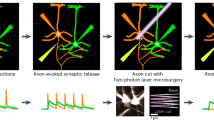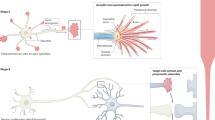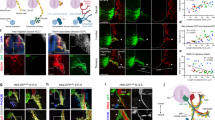Abstract
WHEN the nervous system develops, its constituent neurones establish connections with certain selected elements while rejecting others in a fashion that gives the completed system the precision it requires to function. Such specificity is also manifested during regeneration in the central nervous system (CNS)1–3. For example, regeneration and recognition have been demonstrated with electrophysiological techniques in the leech CNS4,5, where individual sensory neurones can select their normal postsynaptic targets from among apparently hundreds of alternatives, re-establishing chemical synaptic connections. The leech CNS has also provided an example of neurones re-establishing electrical continuity after surgical disruption of a connecting axon6. Such electrically connected ‘S-cell’ interneurones, one of which is situated in each of the 21 segmental ganglia of the leech, are linked at the ends of their axons by electrical synapses across which large molecules cannot pass7. The synapse between two S interneurones occurs in the axon bundles (connectives) that join ganglia. The discovery of this junction and the use of the enzyme horseradish peroxidase (HRP) as an intracellular marker have permitted a detailed morphological and physiological analysis of the steps by which a regenerating axon re-establishes synaptic contact with its proper target. We report here that one such step can be the formation of an electrical synapse between the regenerating neurone and its own severed axon segment, thereby restoring the neurone's functional integrity.
This is a preview of subscription content, access via your institution
Access options
Subscribe to this journal
Receive 51 print issues and online access
$199.00 per year
only $3.90 per issue
Buy this article
- Purchase on SpringerLink
- Instant access to full article PDF
Prices may be subject to local taxes which are calculated during checkout
Similar content being viewed by others
References
Gaze, R. M. & Keating, M. J. Nature 237, 375–378 (1972).
Hunt, R. K. & Jacobson, M. Curr. Tops. Devl Biol. 8, 203–259 (1974).
Yoon, M. Cold Spring Harb. Symp. quant. Biol. 40, 503–519 (1976).
Baylor, D. A. & Nicholls, J. G. Nature 232, 268–269 (1971).
Jansen, J. K. S. & Nicholls, J. G. Proc. natn. Acad. Sci. U.S.A. 69, 636–639 (1972).
Frank, E., Jansen, J. K. S. & Rinvik, E. J. comp. Neurol. 159, 1–13 (1975).
Muller, K. J., Carbonetto, S. T. & Thomas, B. Carnegie Inst. Yrbk 75, 90–97 (1976).
Kuffler, S. W. & Potter, D. D. J. Neurophysiol. 27, 290–320 (1964).
Nicholls, J. G. & Baylor, D. A. J. Neurophysiol. 31, 740–756 (1968).
Miyazaki, S., Nicholls, J. G. & Wallace, B. G. Cold Spring Harb. Symp. quant. Biol. 40, 483–493 (1976).
Miyazaki, S. & Nicholls, J. G. Proc. R. Soc. B 194, 295–311 (1976).
Muller, K. J. & McMahan, U. J. Anat. Rec. 181, 432 (1975).
Muller, K. J. & McMahan, U. J. Proc. R. Soc. B 194, 481–499 (1976).
Perrachia, C. J. Cell Biol. 57, 54–65 (1973); 57, 66–76 (1973).
Hoy, R. R., Bittner, G. D. & Kennedy, D. Science 156, 251–252 (1967).
Kennedy, D. & Bittner, G. D. Cell Tiss. Res. 148, 97–110 (1974).
Birse, S. C. & Bittner, G. D. Brain Res. 113, 575–581 (1976).
Nordlander, R. H. & Singer, M. Z. Zellforsch. 126, 157–181 (1972).
Author information
Authors and Affiliations
Rights and permissions
About this article
Cite this article
CARBONETTO, S., MULLER, K. A regenerating neurone in the leech can form an electrical synapse on its severed axon segment. Nature 267, 450–452 (1977). https://doi.org/10.1038/267450a0
Received:
Accepted:
Issue date:
DOI: https://doi.org/10.1038/267450a0
This article is cited by
-
Regeneration of axotomized olfactory neurons in young and adult locusts quantified by fasciclin I immunofluorescence
Cell and Tissue Research (2017)
-
Regeneration of synapses in the olfactory pathway of locusts after antennal deafferentation
Journal of Comparative Physiology A (2017)
-
The whole-body shortening reflex of the medicinal leech: motor pattern, sensory basis, and interneuronal pathways
Journal of Comparative Physiology A (1995)
-
Axon segments sprout at both ends: tracking growth with fluorescent D-peptides
Nature (1982)
-
The nervous system of the Glossiphoniid leechHaementeria ghilianii
Journal of Comparative Physiology ? A (1981)



